
Mugga Reservoir Upgrade
For most Canberrans, interaction with our water and sewerage networks starts at the tap and ends at the drain. If water flows from the tap, tastes and looks good, and sewage goes away, we’re happy.
Consider Canberra’s water and sewerage networks as an iceberg; most people only see the visible tip. Behind the scenes, dams, bulk supply mains, treatment plants and reservoirs are essential elements to keep water flowing and our lives going.
Reservoirs of all sizes and shapes are scattered across Canberra. They stock drinking water until it needs to be supplied to customers. When it comes to reservoirs, it’s hard to ignore the role of a quiet giant: the Mugga Reservoir.
A quiet giant in Canberra’s background
The Mugga Reservoir is one of Canberra’s biggest water reservoirs. At full capacity, it holds over 45 million litres or more than 18 Olympic pools. Only the Aranda and Spence reservoirs (70 ML) contain more water.
“Mugga reservoir is a drinking water storage reservoir. Water flows to it from our treatment plants and gets stored there. As it’s needed by other reservoirs or by people’s properties, it will flow out from the reservoir and provide the water they need,” explains Icon Water Project Engineer Andre Verbeek-Martin.
The Mugga Reservoir’s role can be a little hard to grasp as it does not always distribute water directly to customers. Instead, its primary role is of a balancing tank. It takes a relatively constant flow of water from our water treatment plant and stores the extra flow when customers need less water. This additional water is available when demand is high, or when there is a maintenance activity at the water treatment plant.
“Every morning, thousands of Canberrans will wake up, flush the toilet and jump in the shower, and that creates a huge peak demand over the network,” says Andre.
“When that happens, the water is going to be fed by Mugga to another reservoir like it. This helps to manage the effect of water demand change on our water treatment plant”.
Mugga is also an older reservoir; it needed a few repairs so that it can continue to perform its important role.
A sizeable project
To protect the water it contains, the Mugga Reservoir needs to be covered. Its massive roof has a surface of around 6,700 m2 or approximately the size of a rugby league field. As the roof was reaching its end-of-life, it needed to be replaced. Large cranes were used to remove the previous roof – which was then recycled. The new roof structure, purlins and cladding were then installed.
The sealing joints between concrete slabs of the walls and floor also needed to be resurfaced to maintain the reservoir’s integrity to store water. The old joints' seals have been restored and covered with almost 3 kilometres of bandages. These will ensure the reservoir is watertight for years to come.
“Mugga was built over 50 years ago. This project rejuvenated the reservoir so it will continue to provide clean drinking water to Canberra for another 50 years or 100 years,” concludes Andre.
The Mugga Reservoir’s new roof is just one of the projects Icon Water is delivering to ensure water security and quality in Canberra. Upgrades to the Googong water treatment plant and the O’Connor Reservoir are just some of the other projects on the way.
 |
 |
|
| Mugga reservoir | View of the new roof from inside | |
 |
 |
|
| New floor joints | New roof |
